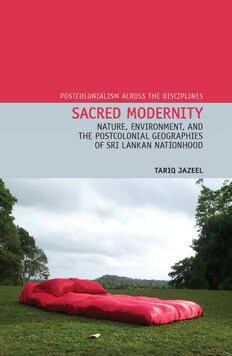Table Of ContentSACRED MODERNITY
NATURE, ENVIRONMENT, AND THE POSTCOLONIAL
GEOGRAPHIES OF SRI LANKAN NATIONHOOD
Sacred Modernity argues how everyday non-secular experiences of
the natural world in Sri Lanka perpetuate ethno-religious identitarian
narratives. It demonstrates the relationships between spaces of nature S
and environment and an ongoing aesthetic and spatial constitution A
of power and the political in which Theravada Buddhism is centrally POSTCOLONIALISM ACROSS THE DISCIPLINES
implicated. To do this, the book works consecutively through two in- C
depth case studies, both of which are prominent sites through which Sri R
SACRED MODERNITY
Lankan nature and environment are commodified: first, the country’s
E
most famous national park, Ruhuna (Yala), and second, its post-1950s
D
modernist environmental architecture, ‘tropical modernism’. By engaging
these sites, the book reveals how commonplace historical understandings NATURE, ENVIRONMENT, AND
as well as commonplace material negotiations of the seductions of Sri M
THE POSTCOLONIAL GEOGRAPHIES
Lankan nature are never far from the continued production of a post-
independent national identity marked ethnically as Sinhalese and O
OF SRI LANKAN NATIONHOOD
religiously as Buddhist. In the Sri Lankan context this minoritizes Tamil,
D
Muslim, and Christian non-Sinhala difference in the nation-state’s natural,
environmental and historical order of things. E
To make this argument, the book goes against the grain of Eurocentric R
social scientific understandings of the concepts of ‘nature’ and ‘religion’.
N TARIQ JAZEEL
It argues that these concepts and their implicit binary mobilizations of
nature/culture and the sacred/secular, respectively, struggle to make I
visible the pervasive ways that Buddhism – thought instead as a ‘structure T
of feeling’ or aesthetics – simultaneously naturalizes and ethnicizes the Y
fabric of the national in contemporary Sri Lanka.
Sacred Modernity shows the care and postcolonial methodological
sensitivity required to understand how ‘nature’ and ‘religion’ might be
thought through non-EuroAmerican field contexts, especially those in
South Asia.
T
‘Expansive and intelligent [...] an entertaining and intellectually A
stimulating book.’ R
Dr Pablo Mukherjee, University of Warwick I
Q
J
Tariq Jazeel is Senior Lecturer in Human Geography at the A
University of Sheffield. Z
E
E
L
www.liverpooluniversitypress.co.uk
Cover image: Paradise by T. Shanaathanan
(2004/Lunuganga). Reproduced with the
kind permission of the artist.
LUP, Jazeel casewrap.indd 1 04/07/2013 07:58:17
Sacred Modernity
Postcolonialism across the Disciplines 12
Jazeel,SacredModernity.indd 1 24/06/2013 08:38:59
Postcolonialism across the Disciplines
SeriesEditors
GrahamHuggan,UniversityofLeeds
AndrewThompson,UniversityofExeter
Postcolonialism across the Disciplines showcases alternative directions for
postcolonial studies. It is in part an attempt to counteract the dominance in
colonialandpostcolonialstudiesofoneparticulardiscipline–Englishliterary/
cultural studies – and to make the case for a combination of disciplinary
knowledges as the basis for contemporary postcolonial critique. Edited by
leading scholars, the series aims to be a seminal contribution to the field,
spanning the traditional range of disciplines represented in postcolonial
studies but also those less acknowledged. It will also embrace new critical
paradigms and examine the relationship between the transnational/cultural,
theglobalandthepostcolonial.
Jazeel,SacredModernity.indd 2 24/06/2013 08:38:59
Sacred Modernity
Nature, Environment,
and the Postcolonial Geographies
of Sri Lankan Nationhood
Tariq Jazeel
Liverpool University Press
Jazeel,SacredModernity.indd 3 24/06/2013 08:38:59
Firstpublished2013by
LiverpoolUniversityPress
4CambridgeStreet
LiverpoolL697ZU
Copyright©2013TariqJazeel
TherightofTariqJazeeltobeidentifiedastheauthorofthisbookhasbeenasserted
byhiminaccordancewiththeCopyright,DesignandPatentsAct1988.Allrights
reserved.Nopartofthisbookmaybereproduced,storedinaretrievalsystem,or
transmitted,inanyformorbyanymeans,electronic,mechanical,photocopying,
recording,orotherwise,withoutthepriorwrittenpermissionofthepublisher.
BritishLibraryCataloguing-in-Publicationdata
ABritishLibraryCIPrecordisavailable
ISBN978-1-84631-886-3cased
SacredModernity
Web PDF eISBN 978-1-84631-997-6 (ebk)
TypesetinAmerigobyCarnegieBookProductrion,Lancaster
PrintedandboundbyCPIGroup(UK)Ltd,CroydonCR04YY
Jazeel,SacredModernity.indd 4 24/06/2013 08:38:59
For Maite
Jazeel,SacredModernity.indd 5 24/06/2013 08:38:59
Jazeel,SacredModernity.indd 6 24/06/2013 08:38:59
Contents
Contents
ListofMapandFigures ix
Acknowledgements xi
Introduction 1
1 SacredModernity:Nature,Religion,andthePoliticsofAesthetics 9
PartI Ruhuna(Yala)NationalPark
2 Landscape,Nature,Nationhood:AHistoricalGeographyofRuhuna
(Yala)NationalPark 27
3 InscriptionandExperience:ThePoliticsandAestheticsofNature
Tourism 47
4 PoliticalGeographies:Promoting,Contesting,andPurifyingNature 72
PartII TropicalModernArchitecture
5 BuiltSpace,Environment,Modernism:(Re)reading‘Tropical
Modern’Architecture 95
6 ArchitectingOne-ness:FluidSpaces/SacredModernity 121
7 Over-determinations:Architecture,Text,Politics 145
Conclusion:SriLankanNatureasProblemSpace 166
Bibliography 171
Index 185
vii
Jazeel,SacredModernity.indd 7 24/06/2013 08:38:59
Jazeel,SacredModernity.indd 8 24/06/2013 08:38:59
Map and Figures
MapandFigures
Map1 Ruhuna(Yala)NationalPark,drawnbyPaulColes,University
ofSheffieldCartographicServices,afterH.W.Jayawardene
(ed.),YalaNationalPark(Colombo:FaunaInternationalTrust,
1993),p.8. 5
Fig.2.1 Wildlife-spottinginRuhunaNationalPark(author’s
photograph). 28
Fig.3.1 MagulMahaVihara(author’sphotograph). 62
Fig.3.2 ‘MyOwnNativeLand’.DailyNews(SriLankannewspaper),3
March1990,AssociatedNewspapersofCeylonLtdarchive,
LakeHouse,Colombo,SriLanka,fromclippingsfileon‘Yala’.67
Fig.5.1 LandscapesatLunuganga,byGeoffreyBawa;terraced
ornamentalpaddyfieldsandLakeDeduwa(author’s
photograph). 97
Fig.5.2 LivingroompavilionatCinnamonHillbungalow,Lunuganga,
byGeoffreryBawa(author’sphotograph). 97
Fig.5.3 RearporchextensiontomainhouseatLunuganga,by
GeoffreyBawa(author’sphotograph). 98
Fig.5.4 ViewoftempleatLunuganga,byGeoffreyBawa(takenfrom
themiddledistance,author’sphotograph). 111
Fig.6.1 WeatheredinteriorwallsintheofficeofMICD(MuradIsmail
andChannaDaswatte)architect’soffice,Colombo,byMurad
IsmailandChannaDaswatte(author’sphotograph). 128
Fig.6.2 TheKandalamaHotel,byGeoffreyBawa,1991(Source:Riza
Jazeel). 129
ix
Jazeel,SacredModernity.indd 9 24/06/2013 08:38:59

